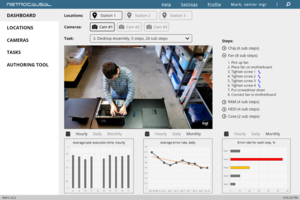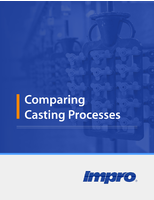New RetroActivity Software Uses Computer Vision Technology
Press Release Summary:

- Offers significant advancements in quality control for manual assembly processes in discrete manufacturing
- Powered by Artificial Intelligence (AI) that identifies errors or missed steps to assembly workers through verbal prompts and visual cues
- Can be loaded onto smart camera system with Wifi connection and an adjustable mount
Original Press Release:
Retrocausal Unveils RetroActivity Software for Improved Quality Control in Manufacturing Assembly
Powered by Artificial Intelligence, this breakthrough system is designed to catch assembly errors in real-time instead of at the end of the assembly line
Seattle, WA – October 13, 2020 – Retrocausal, the leader in visual mistake-proofing software for manufacturing assembly, announces it has released RetroActivity™ software, which offers significant advancements in quality control for manual assembly processes in discrete manufacturing. Powered by Artificial Intelligence (AI), Retroactivity improves overall quality and efficiency by identifying errors or missed steps to assembly workers through verbal prompts and visual cues. The company projects improvements of 10 percent in first-time yields and reductions of 60 percent in manual-assembly related quality issues at a typical factory.
Retrocausal was originally developed to help surgical residents and nurses train for complex medical procedures in collaboration with CAE Healthcare and NASA Johnson Space Center. But the company soon identified an even bigger need in U.S. manufacturing for its technology to provide continuous quality monitoring and training for workers, alongside analytics for industrial engineers and managers. Retrocausal has recently partnered with Siemens Digital Industries Software Co. and is working with some of the largest players in mass-customized manufacturing to improve manual assembly-related quality issues in discrete manufacturing.
Dr. Zeeshan Zia, CEO and a co-founder of Retrocausal, said, “There is a popular belief that robotics will replace manufacturing jobs. However, when compared to human labor, there are many instances of industrial robots being slower, taking up more space, and not being as adaptable as humans. That is why many major manufacturers have recently been turning back to human workers, especially for products that require various degrees of customization for specific usage. But with experienced workers retiring at the highest rates since the industrial revolution, it can be difficult to train new assembly workers and ensure consistent quality control in the assembly process.”
In the last 10 years, temporary employment in U.S. manufacturing has more than tripled. Temporary workers are often less knowledgeable than the rest of the staff, leading to higher training requirements as well as quality and productivity challenges. Another trend in manufacturing is an increasing customer demand for customizations. All these factors are leading to increased quality woes for discrete manufacturers, where Cost of Poor Quality (CoPQ) is already at 20 percent of total sales.
How RetroActivity Works
RetroActivity is a patent pending computer vision technology, powered by AI, that understands complex human activities, as well as the specific details of the parts being assembled. RetroActivity comes loaded onto a smart camera system (6 inches x 6 inches x 2 inches box) with a Wifi connection and an adjustable mount. Alternately, the project engineer can elect to install the RetroActivity software on an existing hardware system or run it on multiple assembly lines through the cloud.
The key points of setting up the system are as follows:
- The industrial engineer records a series of video demonstrations of an expert assembler with each version of the finished product to digitize the bill of process.
- The video demonstrations are used for the AI software to learn a computational step-by-step model of the activity, which is ready to deploy within a few hours.
- Then the system is ready to monitor a worker who is assembling a complex truck panel, a computer system, or any other product or part.
- RetroActivity software provides specific feedback in real-time to ensure that the assembly worker is following the correct procedure for the assembly of a specific version of a product.
- In addition, the analytics dashboard is used by lean engineers to perform root cause analysis and continually improve processes.
Traditionally, manufacturers have focused on two types of tools to improve quality on their lines: (1) machine vision systems for part defect detection, and (2) physical mistake-proofing mechanisms that make it hard to make certain kinds of mistakes.
Dr. Zia adds, “Machine vision systems often focus on Quality Control (QC) stations, which are generally found at the end of the assembly line. In practice, by the time a product reaches the QC station it is already too late. Workers have made their mistakes, and the product either needs to go through another line for disassembly and fixing or be discarded, which are both costly options.”
To date, Retrocausal has raised $1.05 million from a variety of notable industry partners including Incubate Fund US, Techstars, 500 Startups, Atland Ventures, and angel investors from Google AI/IoT and deep manufacturing backgrounds. In addition, they have earned a grant from NASA to build an extra pair of eyes to assist astronauts in performing complex operations while in deep space.
RetroActivity is now available for delivery and can be purchased on a monthly subscription basis. In addition, the Retrocausal solutions engineers are available to help integrate the system into existing manufacturing execution systems. To schedule a demo or to learn more about how RetroActivity can help you improve the quality and efficiency of your assembly lines, please contact them at: http://retrocausal.ai/contact
About Retrocausal, Inc.
Based in Seattle, WA, Retrocausal provides visibility into where workers are on the production line, which step they are on within their station, and how they are performing each step. Their solution, RetroActivity, acts like an extra pair of eyes for workers by assisting them in avoiding assembly errors in real-time, leveraging computer vision. RetroActivity provides workers with live, step-by-step guidance, and alerts them when they make a mistake. They combine recent advances in machine learning and computer vision, including their own prior work, in human pose estimation, 3D object estimation, action classification, and long-term causal reasoning to build novel systems that can understand goal-driven multi-step activities in live video feed. For more information, please visit: http://www.retrocausal.ai/
Media Contact:
Claire Kelly
Account Executive
DPR Group, Inc.
240-686-1000
claire@dprgroup.com




